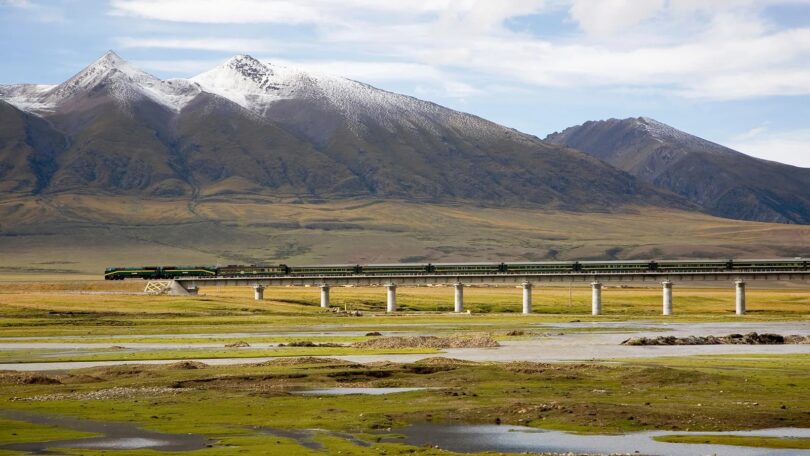Thomas Bird
The Qinghai-Tibet railway stretched before us right across the Himalayan table-top plateau for almost 2,000km, from Xining in central China to Lhasa in Tibet. Despite its epic reach, beyond the window there was little of human provenance, just the yellowed grass of Earth’s rooftop savannah, rippling until it met a horizon shaped like crocodile teeth on the planet’s highest hills.
Should the train have broken down, few passengers would have lasted long in the windswept upland. There were no perceivable wells to drink from nor trees to shade beneath. If anything did hove into view, it was invariably a skeleton: the carcass of a yak picked clean by scavengers, or Mao-era military facilities crumbling like ruins after a war. Even the prayer flags had been stripped of their prayers, white cotton sheets clinging to the rocks signalling man’s surrender.
I thought about those first foreign adventurers who’d attempted to get to Lhasa, the original Forbidden City, like eccentric Thomas Manning from Norwich who, “haunted by the idea of China” sailed from Guangzhou to Calcutta in early 1811. In the company of a Chinese Catholic named Zhao, he crossed the Bhutan-Tibet border unchallenged, and after months of hard travel, set eyes on the holy Tibetan capital, the first Englishman ever to do so. Manning felt Lhasa was dirty and poor, but he nonetheless won an audience with the six-year-old Dalai Lama before the amban who governed Tibet on behalf of Beijing imprisoned him. Manning remained incarcerated until the Jiaqing Emperor ordered he be escorted to the border in chains and deported.
In the decades that followed, China was opened along its coast by aggressive foreign merchants through naval wars and lopsided treaties. But adventurous cartographers, mountaineers, missionaries, gold prospectors and travel writers still dreamed of infiltrating the mystical citadel atop the “roof of the world”. They approached from all directions. Their motives differed, but what they confronted made equals of them all: wolves, earthquakes and smallpox haunted a country that persisted, quite literally, off the map and was peopled by god kings, despotic monks, resolute border guards and armed bandits.

Many died in the attempts that followed Manning. It would be Imperial Britain then that eventually brought Lhasa into worldview when the Tibet Frontier Commission was ordered across the border in India, then part of the British Empire, to rectify trade issues between Britain and Tibet. The Commission was a military unit led by Raj-born Francis Younghusband, who was charged with the vague objective of achieving “satisfaction” for the Empire. He would achieve this satisfaction with the Battle (some say massacre) of Guru. The Tibetans hauled up outside this obscure hamlet were armed with aged matchlocks and pictures of the Dalai Lama they believed would protect them, no match for Enfield rifles and maxim guns that could fire hundreds of bullets a minute. Their ranks were brutally cut down after a rifleman accidentally triggered the British attack when his gun went off. Those who survived simply walked away, unable to fathom what they had just experienced. To their credit, British soldiers set to work rescuing the fallen Tibetans. They then advanced on to Lhasa, fighting skirmishes along the way, including the battle for Karo Pass, noted for being a battle fought at a greater altitude than any other engagement in history.
The British eventually got to the Holy City and although the Dalai Lama fled to Mongolia, they achieved what they wanted – namely a fresh treaty with Tibet signed in 1904.
The legacy of this invasion would transform Chinese attitudes towards Tibet, however. No longer could it be regarded as a loosely controlled protectorate. Through the chaotic decades that followed the collapse of the Qing Dynasty, Tibet enjoyed de facto independence. But in 1950, the Red Army rolled in to “liberate” it from “serfdom”.
Tibetans would not be permitted the autonomy they craved, and many, including the Dalai Lama, fled abroad and embarked on a self-imposed exile.
In 1984, construction of the first section of what would become a symbolic umbilical cord connecting Beijing and its wayward mountain cousin via the highest railway anywhere in the world, was completed, linking Xining with Golmud – a nowheresville in the middle of the province of Qinghai that swiftly became a jumping-off point for a generation of hippies heading to Lhasa.
When travel writer Paul Theroux travelled this line in the mid-’80s, the train was powered by steam and took 30 hours, compared with just seven hours for me by the time of my journey in 2018. “It was a horrible train,” he wrote in his travelogue. Riding the Iron Rooster, before reporting on a scuffle between the passengers and the fact that it “ran out of water an hour after it started”.
I felt somewhat spoiled by my cosy second-class bunk in a carriage fitted with whispering overhead nozzles to regulate oxygen levels and prevent altitude sickness. There was a barrel of piping-hot water at the end of each carriage should my tea flask need a refill. “The world has changed,” I wrote in my diary, “but the Qinghai desert has not”.
Dipping in and out of Theroux’s final chapters as we rolled towards the remote plateau city of Golmud was like receiving a real-time commentary of the passing scenery beyond the window, “square mud-walled villages looked like habitations left over from the Neolithic age” scattered across a plain of stones that is “hellish and memorable” as we rolled deeper still into the “roughest land I had seen in China…”.
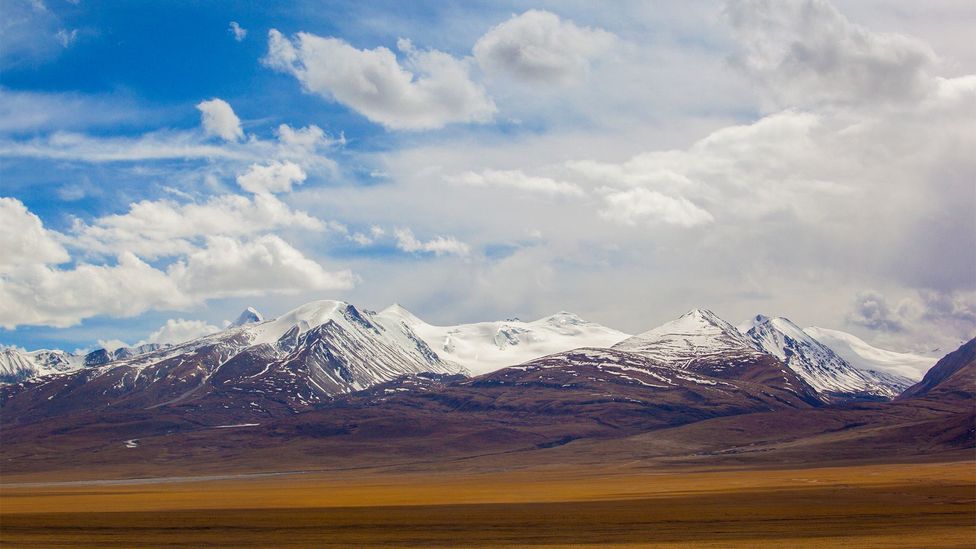
Former Chinese President Hu Jintao called constructing the line from Golmud to Lhasa a “miracle of the world’s railroad history” (Credit: tupianlingang/Getty Images)
But Theroux’s description of Golmud as “a dozen widely scattered low buildings” no longer rang true. Modern Golmud was so new and neat it looked as though it had been transplanted from a model town factory onto the plateau by a helicopter. I couldn’t help but feel the leafy boulevards were somehow in breach of earthly laws, that a manifestly middle-class, semi-prosperous settlement had no place on this plain of rock and skulls.
I spent a night in Golmud, before reboarding the so-called “Road to the Sky” or “Sky Train” to Lhasa the following afternoon.
During the inauguration ceremony that had taken place at Golmud Station in 2006 (this is when the Lhasa section was opened), President Hu Jintao had described the second section of the railway as “a magnificent feat in China’s history of railway construction” and a “miracle of the world’s railroad history”.
Despite the flagrant jingoism imbuing Hu’s speech, engineers really had achieved what many had deemed impossible. The challenges of building the remaining 1,200km of railway across the top of the world were enough to make any right-thinking railway surveyor lie down and try to forget about the whole silly idea. The winter up on the plateau was so tempestuous it had helped earn Tibet the “Third Pole” moniker. Put simply, if you don’t get pulverised by golf ball-sized hail stones or whipped by gusts of mountain wind strong enough to blow a small child away, you might very well lose a few toes to frostbite.
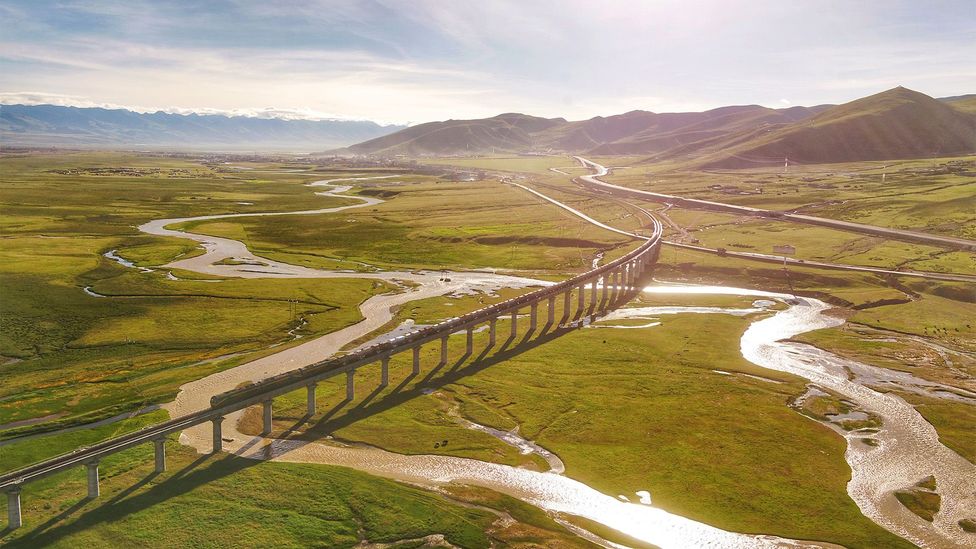
One-seventh of the line’s roughly 2,000km route is built on bridges (Credit: Wang Lu)
The environment posed serious challenges for engineers, too – the biggest problem being 869,000 sq km of permafrost, which was the largest frozen soil region outside of the poles, according to Abrahm Lustgarten’s book, China’s Great Train. Permafrost freezes in the winter but becomes boggy swampland in the summer. For a railway engineer, this implied that in a typical year the ground could rise and fall by as much as 30 cm. Exacerbating the problem was the inconsistency of the thawing patterns, with areas frozen hard in some places and softer in others – an unpredictable lay of the land aggravated by human-induced climate change, particularly as the Tibetan Plateau was heating faster than anywhere else in the People’s Republic.
To overcome those seriously uncertain foundations, a full seventh of the route had been built on bridges, as if traversing running water. Yet even with such provisions in place, this remains the largest continental plate collision zone on the planet and the spectre of a massive earthquake was not an abstract one.
This was why, as my train rolled into view, I couldn’t help but feel a touch disappointed at the routine nature of it all. As I climbed aboard, I discovered the interior of the carriage had been decorated with Tibetan carpets; the walls adorned with traditional Buddhist motifs.
“Ni hao,” I said, attempting to get acquainted with the Tibetans in the carriage, but all they did was giggle.
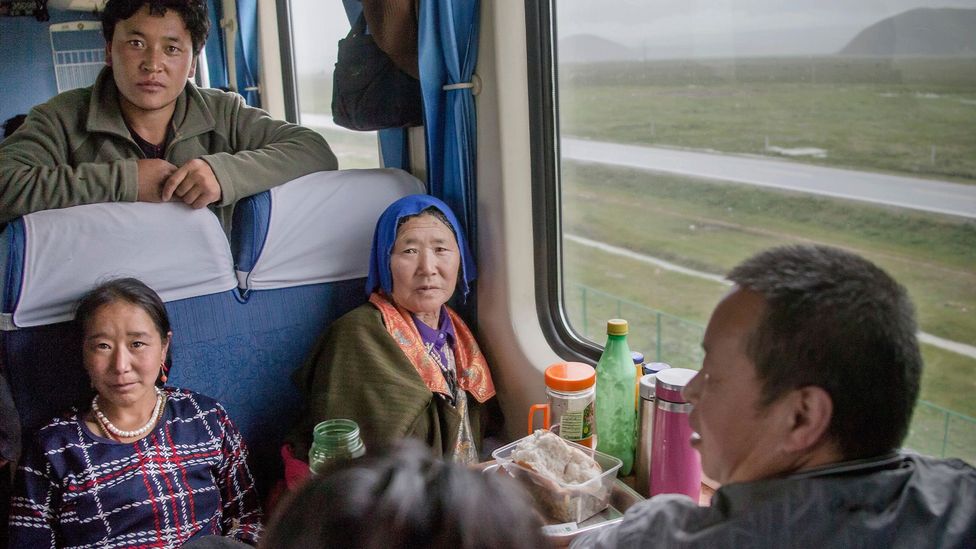
Riding alongside Tibetans is one of the most rewarding parts of the Qinghai-Tibet railway (Credit: Imaginechina Limited/Alamy)
Finding a seat by the window, I perched myself tableside to continue my reread of Riding the Iron Rooster, which concluded with Theroux’s journey from Golmud to Lhasa by road. It was a hilarious, if gruelling episode, a two-day road trip from hell in the company of whimpering Miss Sun and the incompetent driver Mr Yu, who got altitude sick and crashed the car. Alas, Theroux’s brilliant observations did not translate into clairvoyance when he wrote, “The main reason Tibet is so undeveloped and un-Chinese – and so thoroughly old-fangled and pleasant – is that it is the one great place in China that the railway has not reached,” before underlying his insight thus: “the Kun Lun Range is a guarantee that the railway will never get to Lhasa”.
Beyond the train, the great flats of wind-dusted permafrost-tundra were gradually disappearing into the dusk. I slept early and without dinner. At some point during the night, we crossed the Tanggula Pass, which, at 5,702m marks the highest railway in the world.
The following morning I was awakened by a cheerful broadcast concerning the railway’s construction: “The temperature often drops to -20C at night, so it is easy to catch a cold while going to the toilet,” said a woman in robotic English. “To solve the problem, the railway company installed toilets with electrical heaters inside.”
The Chinese were as proud of their Sky Train as they were of their Great Wall or Three Gorges Dam. Yet, to stare at the empty wastes rolling by was to dwell on the pertinent question: namely, why? Perhaps it was just part of their proud history of building the biggest of things, even if, like the Wall that was easily bypassed by invading Manchu cavalry, or the Three Gorges Dam that submerged millions of homes, the reasons for doing it were dubious at best.
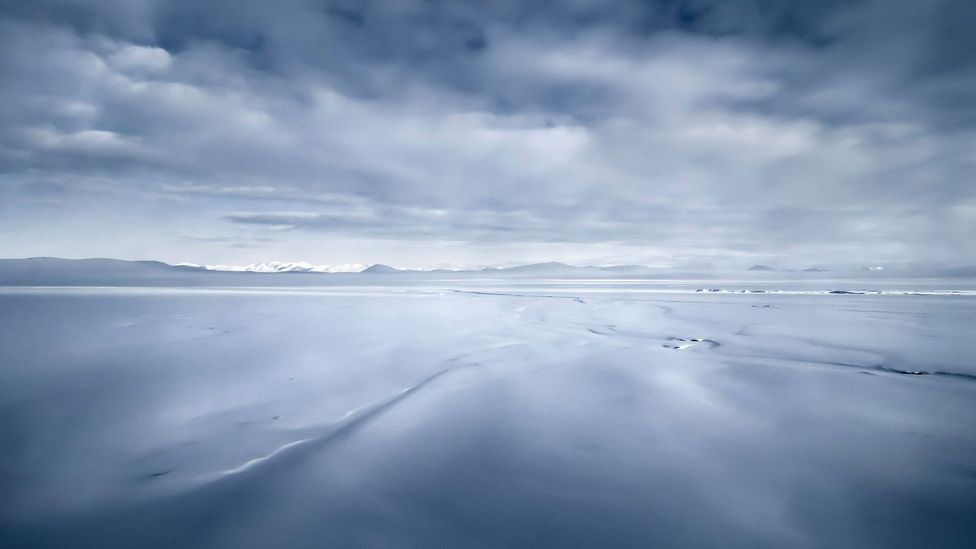
The Tanggula Pass marks the highest railway in the world (Credit: zerega/Alamy)
Officially the idea of China’s Drive West – a policy which aimed to boost economic development in 12 of the nation’s western provinces – was sold on poverty alleviation, and on its completion in 2006, the railway did initially make good on this promise, ushering in a regional tourist boom with 2.5 million visitors arriving in the first five months. This triggered above-national-average growth, which in turn, led to the radical remodelling of Lhasa with hotels, paved roads and condominiums, a transformation mockingly dubbed “Tibet’s Second Invasion” by critics.
But the boom had not lasted and the Tibet Autonomous Region remained China’s least-developed place when I rolled through it. Beyond economics, it was more reasonable to consider the railway’s strategic value. As Tim Marshall, author of Prisoners of Geography, put it in cold, geopolitical terms, “If China did not control Tibet, it would always be possible that India might attempt to do so.”
Then there was the railway’s role in nation-building. Vast countries like the US and Russia had been forged by iron roads, much of which had been laid by Chinese coolies, while at home, the colonising power of a railway had been felt when foreign powers laid tracks throughout China during the 19th Century.
Yet in the wild scene beyond the window, geopolitics felt like a distant, humancentric thing. Passage to Lhasa followed the Kyi Chu, a northern tributary of the Yarlung Tsangpo River gushing through a brittle valley flanked by black jagged peaks ending in shards that viciously pierced the cotton wool clouds. This truly was a “stone citadel”, I realised, which went some way to explaining why it was arguably the last medieval city to fall to modernity.
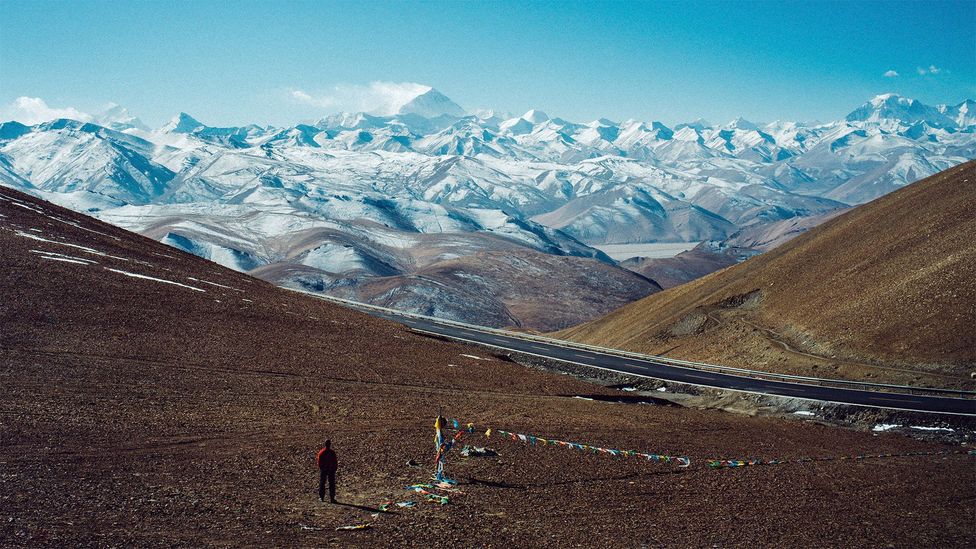
For years, it was thought that a train line could never reach Lhasa (Credit: donwogdo/Getty Images)
Lhasa’s allure to any world wanderer worthy of their boots was self-evident: its remoteness, its strangeness and despite the forces of globalisation and Sinification, its isolation. It was 3,700km from Beijing and 284km from the nearest foreign capital, Thimphu, Bhutan. Even with the train, Lhasa was still the most out-of-the-way place to get to.
I finally stepped down from my carriage feeling conversely weary and refreshed. But before I’d had time to take a whiff of Tibetan air, a security guard was pointing me to a large white tent where all foreign visitors must go to register their arrival.
After some long minutes, a red stamp and a signature signalled that I was free to go. But, as regulations stipulate you must book a tour with a registered travel company, freedom doesn’t last long in Lhasa, only the length of the station forecourt, beyond which a cheerful Tibetan holding a sign splashed with the travel company logo asked, “Are you Mr Bird, Thomas?”
“Yes, that’s me.”
“Welcome to Lhasa.”
He put a white silk scarf around my neck, the traditional Tibetan welcome, then ushered me aboard a mini-bus packed with awkward-looking foreigners. We chatted briefly as we rolled towards the Barkhor, the historic centre of Lhasa. It turned out I was the only one who hadn’t arrived by plane.
Courtesy: BBC

